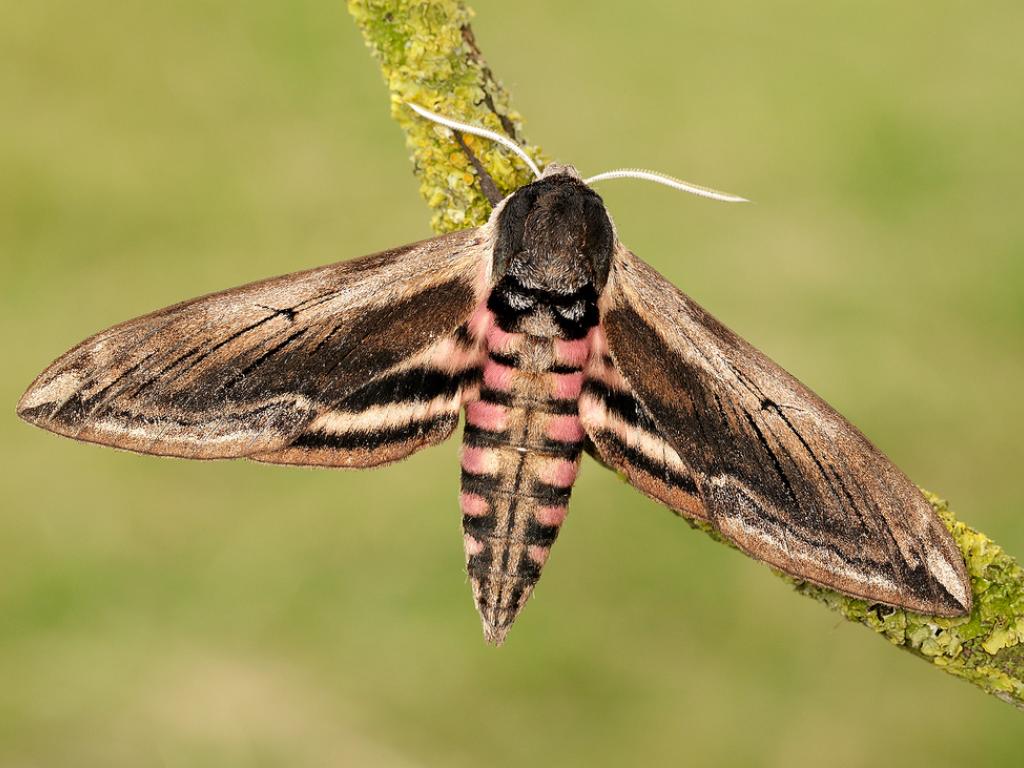
Privet Hawk Moth tricoloured caterpillar. Credit Marilyn Hepworth.
Don’t panic!
This beautiful caterpillar, photographed locally by Marilyn Hepworth in her garden, is the larva or child stage of the Privet Hawk-moth (or Sphinx ligustri). It was seen feeding on her lilac, although as its name suggests, the caterpillar is very fond of privet. Other food sources include honeysuckle, ash, vibernum, forsythia, spirea and guelder-rose. However, these caterpillars do not flourish in sufficient numbers to cause significant damage to the plants (so don’t panic if you see one!).
The body of the caterpillar is large, up to around 10 cm. As shown here, it is bright green, often with a purplish cast, with purple and white stripes on its side and yellow spots on each segment. The black horn on the rear of the caterpillar is not for stinging but is thought to present a decoy image to predators that is defensive; however, the horn’s function is still open to debate. What is clear is that the caterpillar, like the moth, is harmless to humans. The caterpillar is preyed upon by birds, bats and small mammals.
The moths lay their eggs around June and July, and the caterpillars can be found between July and September. The best way to find them is by looking on the ground where they drop dark pea-sized faeces said to resemble tiny hand grenades. In September the caterpillars descend into the soil, going up to 30 cm underground, to pupate. The transition from caterpillar to pupa (or the child to the pubescent stage) happens as the caterpillar’s skin splits and a dark brown chrysalis begins to emerge, this acting as a kind of mould in which are formed the external features of the moth. This is dark brown with a small loop at its head and a sharp point at the end of its abdomen. If you unearth a pupa (or chrysalis) and look closely, you can see recognisable surface features of the moth that will emerge in spring: the small wing cases, leg cases, proboscis case and the head.

Privet Hawk-Moth Credit Iain Leach
The adult moth is a gentle giant, one of the largest hawk moths, with a torpedo-shaped body and a wingspan that can reach 12 cm. It is also one of the strongest fliers of all the moths. There are nine species of hawk moth that breed in the UK and we are visited by eight other species. The moths fly at night and travel long distances in search of mates; they are also attracted to light so are often found in moth traps.
The Privet Hawk-moth has dark brown- and cream-coloured wings, and pink and black bands on its body and abdomen. It can be found in gardens, woodland, hedgerows and coastal scrub, taking nectar at night from highly scented flowers such as jasmine and honeysuckle. Before taking flight, the moths often rest on vertical objects such as posts and trees, where they are well camouflaged. Unlike butterflies that warm up in the sun, these moths warm up by ‘shivering’ their wing muscles to prepare for flight. If disturbed, they can make a warning hissing sound by rubbing the scales and spines at the end of their abdomen.
Although ash dieback is reducing the food available to the moths, they are not seen to be endangered in the UK.
Information for this article was taken from—
Butterfly Conservation (https://butterflyconservation.org) The photograph of the adult moth was taken by Iain Leach and used with the permission of Butterfly Conservation
Plantura Magazine (https://plantura.garden)
Privet Hawk-moth—Natural Lizard 2015:7-15
Wildlife Trusts and Woodland Trust websites
